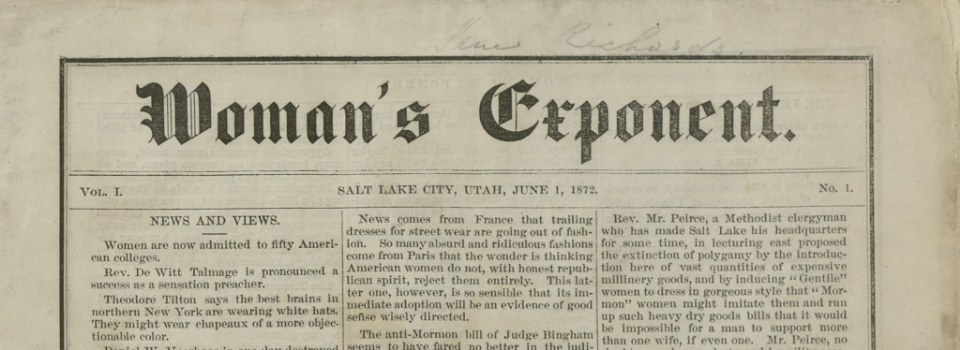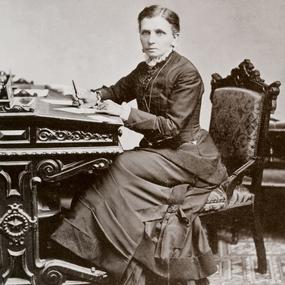- Emmeline-B.-Wells-2
- Emmeline-B.-Wells-2
- Emmeline-B.-Wells-2
- Emmeline-B.-Wells-2
- Emmeline B. Wells-2
- Eliza R. Snow
- Women's Exponent
- Women's Exponent
- Women's Exponet
- Women's exponent
| Temple Square is always beautiful in the springtime. Gardeners work to prepare the ground for General Conference. © 2012 Intellectual Reserve, Inc. All rights reserved. | 1 / 2 |
This story appears here courtesy of TheChurchNews.com. It is not for use by other media.
By Rachel Sterzer Gibson, Church News
In the October 15, 1876, edition of the Woman’s Exponent, the newspaper created and produced by the Relief Society, a contributor called “Inez” related an experience at a fast meeting. A brother commented that it was the sisters, more often than the brethren, who would turn out to perform religious duties. “The sisters,” he said, “form substantially the back bone of the Kingdom of God!”
Inez reflected, “Of what use would a head be without a backbone to assist in keeping it in its proper position? It would be worth just about the same as a kingdom of men without women.”
She then shared her gratitude at being “numbered with a people whose men accord to woman’s worth so fair an estimate.”
Historians will tell you how difficult it can be to find women’s voices in historical records. If you’re lucky, you might find letters or journals or passing references found in secondary sources, which were most often recorded by men.
And yet in the pages of the Woman’s Exponent, displayed in vivid detail like the account above, are firsthand accounts of the thoughts, feelings, opinions and experiences of women in early Church history.
The Woman’s Exponent, which was published from 1872 to 1914, has been digitized and made available by the Church History Library. Earlier this year, the library also finished releasing a series of 12 articles on its blog about this remarkable trove of stories that give insight and an in-depth look into the lives of women of The Church of Jesus Christ of Latter-day Saints in frontier Utah and beyond.
What It Was for Women Then
The purpose of the journal was outlined in its first issue on June 1, 1872: “The aim of the proposed journal will be to discuss every subject interesting and valuable to women. … It will aim to defend the right, inculcate sound principles, and disseminate useful knowledge.”

Women's Exponet
A copy of the first edition of the Woman’s Exponent (1872–1914), a bimonthly newspaper created and operated by members of the Relief Society.2020 by Intellectual Reserve, Inc. All rights reserved.The intention of the publication was also captured in its name. It was an exponent — something or someone who believes in or promotes the truth or benefit — of woman.
“We are of the women of Utah and proud to be so recognized,” it states in its first issue, “and our object is to sustain truth, spread a knowledge of correct principles and labor to do good.”
It was a publication by women for women. The authors, editors, even the typesetters were all women, noted Anne R. Berryhill, a historian and archivist in the Church History Department.“The paper provided a public forum wherein women could publish their opinions and experiences — not only for women who were members of the Church, but for a much wider audience too.” Through its pages, female members of the Church, who often felt underrepresented and misrepresented by others, were given a voice, Berryhill explained.
Plural marriage was a particular topic addressed through the Exponent. In impassioned editorials, authors and editors combated other published contemporary accounts of Latter-day Saint women practicing plural marriage, but letters to the editor also addressed the topic, Berryhill said. For example, a sister from Kaysville (cited in the paper as “S”) wrote a letter to the editor on Sept. 26, 1872. “I felt thankful that our Father in Heaven had given us an opportunity of expressing our feelings with regard to polygamy …,” she wrote.
The newspaper discussed much more than just polygamy, however. It contained content on everything from fashion, home tips, marriage and child care to faith, politics, women’s rights and suffrage, and women’s right to work. It gave women a safe place to share their thoughts, feelings and opinions, even when they expressed opposing views about politics, child rearing, homemaking or education.
For example, in May through July of 1875, Emily B. Spencer and “Inez” volleyed back and forth editorials about what it means to be a “strong minded woman.” In a blog post titled, “Woman’s Exponent — The Great Debate: Editorials and Opposing Views,” Church history specialist Jen Barkdull noted, “While these written conversations were ardent, they were not mean-spirited in tone. … The women of the Exponent show us that we can have differing opinions and still maintain courteous exchanges.”
The Exponent also helped create unity among the women of the Church as it grew and it was not feasible to gather physically. It was the social media of its time, Barkdull noted — it connected women with other women and ideas they never would have known or come into contact with otherwise. In a Relief Society conference report published in December 1882, for example, the Relief Society in Bern, Switzerland, reports on a meeting they had.
“They felt that, as part of a worldwide Relief Society, it was important to report on their work,” Berryhill said.Without Google or the internet, women had to rely primarily on one another for everything from cold remedies to spiritual upliftment. In the pages of the Woman’s Exponent, they shared ideas and information they encouraged each other. The April 1, 1882, edition contained a section titled, “The Family Doctor-shop” for women to “paste this up for reference in case of emergency.” The column contained suggestions for treating everything from neuralgia and sour stomach to broken bones and sleeplessness. It also contained a list of everything a family needed in their cupboard, just in case.

Women's exponent
The Fifteenth Ward Relief Society, circa 18872020 by Intellectual Reserve, Inc. All rights reserved.“In every house there should be a little nook in which a few simple remedies are kept. Among them should be extract of ginger, Dover’s powder, peppermint, chlorate of potash, bicarbonate of soda, sweet oil, paregoric, camphor, arnica, a bottle of pure whisky, cotton, old muslin for bandages, some sticking-plaster, a box of ground mustard and some ready-made plasters. Always strike a light when you go to get any of these in the dark, and be sure you have the right one. (Reprinted from the Sparta Herald.)”The women also used the Exponent to “inculcate sound principles” by expounding scripture and discussing gospel topics. In an editorial published on June 15, 1878, Hannah T. King, a regular and well-known contributor, lamented, “I hear intelligent educated women exclaiming ‘I cannot read the Scriptures, they are so deep, I know nothing about them.’” She promised that through the scriptures, women will be “enlightened, strengthened, and invigorated” and find “panacea” — a cure for all ailments.
“The articles of the Exponent empowered and taught women that they too could read the scriptures, be scholars, and rely on one another to be uplifted,” wrote Faye Fischer, a Church history specialist, in one of the 12 blog posts about the women’s newspaper.
What It Is to Women Today
The pages of the Woman’s Exponent have broad application for latter-day women in the Church. For one thing, the content can provide great insight for family history buffs. Berryhill gave the example of Caroline Crosby, featured in “Saints: Volume 2,” who has a short obituary — less than 100 words — published in the Deseret News. The memorial essay published in the Exponent, however, includes a poem penned by her husband and detail about her background, baptism and journey West, as well as her missionary service in the South Pacific.
“This kind of content could be particularly helpful for family history researchers,” Berryhill said. “Through it, they can find helpful information regarding events and accomplishments in the lives of Latter-day Saint women.”Perhaps more important, however, the Woman’s Exponent represents a shared history for female Church members today, Berryhill said. “We see women fighting for their right to vote. We see women participating in projects that contributed to the welfare of their larger communities — nursing/midwifery, grain storage, education, etc. We see women who felt misunderstood and misrepresented by their non-member peers. We see individual women who did their best to cultivate themselves, care for others in their communities, and serve in their local units.”
And regardless of whether their ancestors are featured in its pages, women today can find connection in that shared past. In the final blog post of the series, Barkdull shared how as a convert to the Church, she felt disconnected from the pioneers. But researching the Exponent has helped her realize that “the women who contributed to the Woman’s Exponent were women like me. They experienced ups and downs with life. They worried about their children. They worried about whether they should get an education, go to work, or stay home with their children. They were concerned about their country, wars, and women and children in other countries. They wanted the best healthcare for themselves, their families, and their communities. They wanted to ensure women had a voice in their homes, churches, and communities. They were strong and resilient. They cried, laughed, teased, and were sarcastic. The Woman’s Exponent gave me the opportunity to get to know these women and recognize that they are a part of me, even as a convert. They have a place with the women of the Church, and so do I,” she wrote.

Emmeline B. Wells-2
Portrait of Emmeline B. Wells taken January 14, 1879. Emmeline B. Wells traveled to Washington, D.C., in January 1879 to attend the annual convention of the National Woman Suffrage Association. In her diary entry of January 14, Wells noted, “This morn. went to Photo-gallery had pictures taken.” The photograph was taken at the Charles M. Bell studio in Washington. Photo courtesy of Church History Library.nullThe purpose of the newspaper, as expressed in the very last issue by Emmeline B. Wells, who served as editor of the publication and as general Relief Society president, in the very last issue is timeless:
“The aim of the paper has always been to assist those who needed assistance in any or every line. … For women, [the paper] has been a standard bearer, proclaiming their worth and just claims throughout the long years of its existence. … We love the readers of this paper as a part of ourselves; we love women and would ever strive to uplift and help them to attain their ideals; we love the Latter-day Saints and we love the Relief Society — that great organization which this little paper has ever sought to represent and build up; and may our Heavenly Father ever have in His gracious care, the women, whose life service is the regeneration of mankind.”
Resources
Digital copies of the Woman’s Exponent can be found on several websites:
- The Church History Catalog
- Utah Digital Newspapers
- The Digital Collections on BYU’s library website
- The Church History Library blog, https://history.churchofjesuschrist.org/blog/the-historical-record, also features 12 articles about the impact and influence of the Woman’s Exponent.
(Research tip: When doing searches in these databases, leave out initials. A search for “Eliza Snow” or “Eliza Roxcy Snow” will yield better results than “Eliza R. Snow.”)